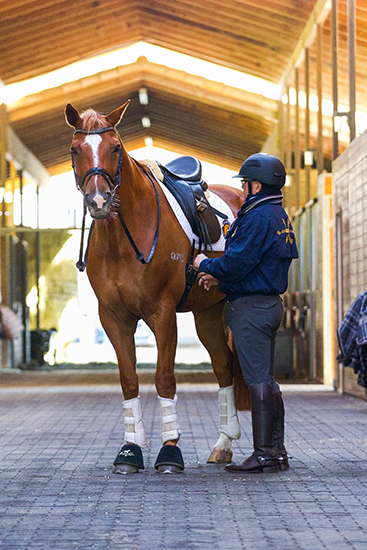 Story by Karen Hosie, and Terri Miller took the fabulous photos exclusively for The Horse Magazine
Story by Karen Hosie, and Terri Miller took the fabulous photos exclusively for The Horse Magazine
Once upon a time, a long time ago (well in the 1960s) in a land far, far away (OK, Papua New Guinea, but far is a relative concept) there lived a little boy named Gary. Gary was a modest and humble child, who was taught to be polite and considerate, put others first and always respect your elders. Now little Gary loved animals dearly and dreamed of one day having a pony of his very own.
But Gary wasn’t like all the other children, who lived with their Mummies and Daddies, had 2.4 brothers and sisters and a pony with a stable in the backyard. Oh no, although Gary lived with his parents, he also lived with his outspoken aunties and grandparents and little Gary had to work very hard indeed in the family business. Gary’s parents did not much like animals – “too much mess they said, too smelly. You have no time for animals; you have too much work to do,” but little Gary bought an unfortunate-looking mare that nobody wanted and kept her a secret from his parents, and she became his best friend in the whole world.
One bright morning Gary grew up, packed his bags, and headed off for a great adventure. He travelled far, far away, all the way to Brisbane. He worked very hard, was polite, considerate and always respected his elders, but something was missing, he missed his best friend. So Gary decided to buy a bright, new, shiny horse. The bright, new, shiny horse was a lot harder to ride than the unfortunate-looking mare and Gary had to learn many new skills to stay on top and perform for the judges. But Gary was a hard working and dedicated pupil and one day he built a big orange horse all of his very own (OK so he had a little help from Glennis Barrey, the breeder as well). Gary taught the big orange horse to be very polite and respectful, to listen carefully and always do what he was told. Just like Gary, the big orange horse was also a hard working and dedicated pupil. Now, one day the big orange horse was chosen to ride in a very important Masterclass. A Wizard was coming to teach special magic skills…
The Wizard had been searching far and wide for a new apprentice to live in his castle. Many young horses had gone to see the Wizard, seeking their fortunes, but alas, none had interested the Wizard at all. When the Wizard arrived at the Masterclass he was enchanted with the big orange horse and invited him to his castle, far, far away, in a land over the sea, where he could teach the horse all the special magic he knew in time for a big tournament. But alas, poor Gary was not a very, very rich man. How could he afford to send the big orange horse to the land where the Wizard lived?
One night when Gary was sitting all alone wondering what to do, a miracle happened. Because Gary is always polite and considerate, puts others first (and always respects his elders) his family and friends secretly gathered enough gold for him to make the journey. It wasn’t long before Gary and his big orange horse found themselves flying over the clouds to see the Wizard. The Wizard was delighted; he gave the big orange horse the best room in the castle and immediately started teaching him all the special magical skills he knew.
Now…I don’t know how many of you still believe in miracles… but it surely makes for one heck of a good story and every word is true!
The fact is that Steffen Peters simply ‘fell in love’ with Gary Lung’s horse, GB Winchester (Chester), when he met and rode him for the first time on day one of the three-day Mitavite Ultimate Masterclass. What followed was a whirlwind courtship resulting in Chester flying to San Diego, being given the red carpet treatment from the moment he hit the tarmac and promptly being ‘installed’ (sorry, couldn’t resist the pun) in Ravel’s old stable, next to Steffen’s office; with double rubber padding, hot and cold running high tech gadgetry and quite simply the best in the barn. Steffen is working his magic and already Chester has caught the eye of at least one Olympic level judge who said, “If I could bottle that horse’s walk and sell it I’d bet set for life.” So why all the fuss…?
Well folks, to answer that we need to go back to the beginning…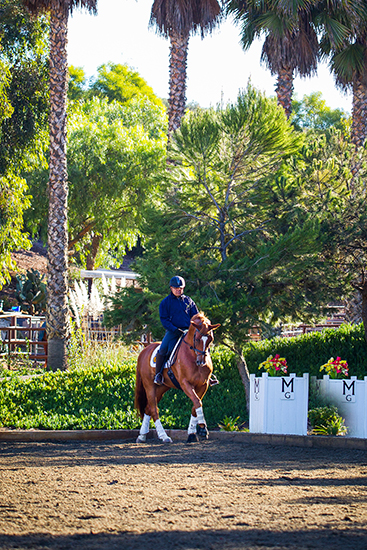
THE EARLY YEARS
Gary was born to a second generation Chinese family in Rabaul and grew up in Port Moresby. At this time PNG was still a protectorate of Australia and when PNG gained its independence in 1975, Gary’s family retained their Australian citizenship. Living in an extended family with close links to the Chinese community and attending an international school gave Gary an extremely cosmopolitan upbringing. Interestingly, PNG is one of most culturally diverse countries in the world with over 840 different languages listed for the country. Gary’s extended family established a successful appliance retail and wholesale business. Members of the family worked in this business including Gary whose first job was working in the video library after school.
Gary where did your love affair with horses start?
“Well, I must have been around eight or nine and we all went off to the annual Port Moresby show. I remember sitting there looking at the centre ring, looking at all the horses and kids riding ponies and I thought ‘I’d love to have a ride.’ So I hung around until I could ask someone where do you keep your horse, and how much does it cost to buy one, thinking that they would be fairly cheap and I had quite a bit saved up in my money box. The kid I asked said that his horse cost one hundred dollars. So I thought, that’s okay I can do this, I went home, got my pennies out, counted one hundred one cent pieces and went to Mum and said that I’ve got the money to buy a pony.” [all of a dollar – gorgeous!]
This idea of a pony however didn’t go down particularly well with Gary’s parents; they weren’t at all horsey. So Gary adopted a new strategy and “befriended anyone at school that had a horse.” He quickly fell in with a chap named Tim Lindgren who became one of Gary’s closest friends. The Lindgren family were all horse mad and Gary adopted Tim Lingren’s mother’s horse. He was an old retired gelding, but he had four hooves and a tail and Gary thought he was just great. For the next few years Gary was loaned every old and tired bit of equine flesh that no one else wanted. They were all beautiful show horses to Gary and he brushed them, loved them, and rode them in all manner of tatty, old, ill-fitting gear wherever he could persuade someone to take him.
One day a local stock station was closing down and all the horses were being auctioned. “So”…thought Gary, who by this stage was now a strapping 12-year-old with a much healthier bank balance due to working three days after school and Saturday mornings every week stacking videos in the family business, “This is it, I am really going to buy myself a horse.” So he rang up the owner, a Mrs Gill who said that she had the perfect horse for him ‘a lovely mare’ and that she wouldn’t put her through the auction if he came out and had a look at her. So off he went… According to Gary: “she had just been broken in and was an ugly, ugly little stock horse, plain, brown and totally uneducated with absolutely no brakes but I thought she was Christmas, I loved her to bits.”
So how did you get around your parents aversion to horses and how did they were cope with this new addition to the family?
“Well they didn’t cope with it because I didn’t tell them.”
OK bold move, so how did you buy the horse?
“Well, I went to my uncle. Everyone has an Uncle Fred and mine was my Mum’s youngest brother. He and his wife didn’t have any kids of their own and they looked after all the nieces and nephews. So I said Uncle Fred I would like to borrow some money to buy a horse. He said ‘that will be great, you can race it and I can bet on it.’ All my family are gamblers except for me, I don’t gamble.”
“Anyway he loaned me the money, all of 400 Kina back then (which was still a lot of money) and I bought the horse. Now I had the problem of where to keep it. Anyway another friend of mine, Roddy Robinson, had a paddock out the back, so into this weed-infested paddock with broken down fences went my new horse.”
“Then I realised that I didn’t have any gear, so I rode everywhere in a halter, until Roddy gave me this bag of broken bridles and I managed to cobble together enough bits and pieces to make a workable bridle of sorts. I still didn’t have a saddle and rode for a year without one but that was okay, I did not care, I finally owned a horse and was able to ride her anytime and anywhere. I did everything on her, I started going to Bomana Pony Club at the Port Moresby Turf Club just outside of town. I started to take part in anything that was horse related and I even used to ride her around town to visit all my friends and family. No one had floats in Port Moresby, we just rode everywhere.”
Still without a saddle?
“I finally bought this second-hand saddle and it was a bit tired looking so I thought I would polish it, now it would be fair to say at this point that I had no idea how to do this. I remember thinking boot polish works on boots as they are leather, so I used black boot polish. Now I only had one pair of joddies that Mrs Lindgren was kind enough to buy for me, they were way too big for me and I completely ruined them riding in that newly polished saddle.”
All this said, it was a great learning environment for Gary. Most of the horses were agisted at the turf club or in little pockets nearby. There was a really strong cooperative atmosphere enjoyed by all the riders and over the next ten years Gary had a go at every horse sport available to him including Pony Club, showing, dressage, steeple chasing, showjumping, racing, eventing, polocrosse and polo. The Equestrian Federation of Australia (EFA) was the governing body for all equestrian events in PNG.
What was your favourite type of riding?
“I loved it all, you name it I did it. As I got older I began to instruct at Pony Club, which was great. Looking back, although I didn’t specialise in any one discipline, the opportunity to ride in so many different sports has shaped my horsemanship skills and knowledge. We were mad, as kids, we used to dare each other to jump anything; we used to jump through the open-sided bus shelters, old cars, anything. We used to go to the local motocross track and gallop flat-out racing the motorbikes. We had so much fun.”
FOOTLOOSE AND FANCY FREE
And so the years passed. In 1986 Gary left PNG and moved to Brisbane, shortly followed by a two-year stint in New Zealand’s Manawatu. Gary continued riding whenever possible and generally staying involved in all things equine.
Then in 1998, quite by chance, Gary had the opportunity to spend five months in Japan at the Hokso Riding Club, which belonged to Tadayoshi Hayashi. Tadayoshi is one of Japan’s most successful showjumpers and competed in the Olympics in Athens and throughout Europe at major shows. Gary’s job was to train showjumping horses and riders: “It was really challenging to teach with such little Japanese … I ended up teaching about 20 riders of varying levels and most had only limited English.”
Did this change your outlook at all?
“Well it certainly improved my teaching… I had to learn Japanese terms and really dig deep to find ways and strategies to get the message across. I discovered that checking for understanding was a key element. I discovered a number of ways to do it which has helped not only in my equestrian coaching, but skills that I use today in my profession as a Training and Development Manager.”
So back to Australia for good after that?
“Not quite, in early 1990 I also spent three months coaching riding in America, Palos Verdes just outside LA. It started as a non-horsey holiday and while there I was introduced to friends of friends who had horses. They asked me to come and ride and to cut a long story short, they liked the way I rode and handled their horses, they asked for some help, loved the lessons and the word spread and before I knew it I was coaching up to five students per day.”
MEETING GLENNIS BARREY AND DISCOVERING DRESSAGE
So when did you begin to specialise in dressage?
“Every horse I rode in PNG was in some way ill-bred, in-bred or ruined: it was either off the track, had a bad mouth, was lame, its mind was fried or it had something wrong with its health, I thought that a stiff and unbalanced horse was normal. It wasn’t until I started riding here in Australia that I realised you could actually ride and buy a horse that’s schooled. A schooled horse, what’s that? Wow. This was such a contrast coming from somewhere where you had to make your own horse, to being able to buy one readymade off-the-shelf.”
“It was at about this time that I started riding a big 17.1hh Thoroughbred that loved eventing and was a great jumper, but was not so good at dressage, really stiff. I used to hate dressage, I thought it was so boring, couldn’t understand it and certainly couldn’t make the horse do it. Since it was the part of eventing I needed the most help with, I decided I had to do something to improve it.”
“A friend recommended that I attend a Glennis Barrey clinic. Glennis travels to the Gold Coast and Brisbane on a regular basis to conduct her clinics. We started to work with this horse of mine, with Glennis teaching me to use gymnastic exercises to loosen and supple him; it was a light bulb moment. After these exercises, I felt my horse give and let go in his back and he felt incredible. It was a really transformational moment for me, I thought oh my god, so this is what it feels like. Glennis is a short, slight person, yet she could get on these great big horses without kicking or banging and crashing but instead use exercises to really make them move. Well that was it for me, I was hooked. Glennis became, and still is, a great coach and mentor for me.”
Glennis is a fairy tale herself, as a young rider she travelled to Germany, with her father Don Scott’s backing. She studied with many of Germany’s leading trainers, Bimbo Peileke, Udo Lange and the Klimke family and not for three months, for two year stints in the years from 1983 to 1990 when she was part of the Australian dressage team at the first WEG in Stockholm. And it didn’t finish then, Bimbo Peilike continued to come and work with Glennis, and others, two or three times a year up until his recent death.
It was from Glennis that Gary was to eventually buy a very young and rather cute orange colt out of a mare she competed, Saffron, and by Weltmeyer: GB Winchester, but that is still a long way in the future.
Gary now began to train with various coaches and coach educators throughout the country. In 1992 he obtained his EFA NCAS Level 1 qualifications. His professional life was also taking on an increased level of commitment and Gary commenced his Bachelor’s Degree in Education at Griffith University. These were busy years for Gary; he spent a year training with the late Edgar Lichtwark and then Clemens Dierks, and attended several clinics run by Matthew Dowsley and Joern Kubelke. In 2008 Gary attended the three-day Masterclass with Andreas Helgstrand at Equitana.
So many different trainers, yet all of them have given you pearls of wisdom no doubt?
“Absolutely, rather than each one contradicting, they rather build a network of ideas, I call them tools for my tool box, for instance Edgar taught me how precise and accurate transitions and movements have to be ridden. Clemens showed me how important it was to work a horse over its back. Matthew taught me that using the shoulder-in helps to bringing the back up. Joern, how to show and ride for young horse classes and Andreas, the importance of transitions within each pace.”
In 2009 Gary began attending Leonie Bramall’s dressage clinics organised by Jenny Gehrke at Kate Wilson’s property on the Darling Downs. Gary describes Leonie as a very feeling rider. “She somehow has the ability to ride with you, like she is in your head and feels everything that you do. She is really strong on motion and movement and sees what parts of the body to work on to improve it. Her co-ordination is perfect and she can relay messages to you instantly so you can apply them to the horse.”
“In 2010 I went over to her barn near Hannover in Germany for a month. I got to ride three to four horses per day under her watchful eye, it was fantastic. Leonie really helped me with my position; we spent hours in Pilates bands to assist my leg position and balance. The bands help to centralise your aids and tidy everything up. It was like learning to ride again. The other thing is, despite all her success she always adopts a very humble approach to her students and really listens to their issues. Some of her comments that have influenced me the most are ‘half-halt in the front and activate the hind legs’, ‘ride through the horse’s body’, ‘connect the legs to the hands’, ‘pick up the outside hind leg and step it into the inside front leg and always, always keep the ribcage up.’”
For those of you not familiar with Leonie Bramall, she originally hails from Canada and moved to Germany when she was 18 to train with Johann Hinnemann. It was during this time that she trained alongside Steffen Peters, a fellow student at Johann’s stable. She represented Canada in dressage at both the Barcelona and Atlanta Olympic Games. Leonie now lives permanently at Isernhagen, Germany with her partner Volker Dusche and together they run Gestüt Mühlenort a dressage training stable and stud. Leonie travels regularly to Australia and New Zealand to teach.
In the early part of 2011 Gary began to train with Nicole Magoffin. Nicole had recently returned to Australia after spending six months in Del Mar training her Grand Prix Horse Jaybee Anzac at Steffen Peters’ barn. While there she developed an immediate rapport with both Steffen and Lientje Schuler, Steffen’s assistant trainer. It was during this time in Del Mar that Nicole developed the initial idea of the Ultimate Masterclass. Training with Steffen was a really transformational time for Nicole. So when she came home, she really wanted to show her own pupils the way Steffen trained and subsequently invited Lientje to come over to Australia and hold a series of clinics.
Any words of wisdom from these two?
“Nicole focuses on how light and reactive horses should be trained. Lientje really concentrates on how straight your horse has to be.”
GARY’S TRAINING ROUTINE AT HOME
I can imagine balancing the demands of a career in the city and running dressage stables to be quite a juggling act, could give me an outline of a typical week?
“I start working the horses at around 5.00am and I normally work two horses before seven. Sometimes I fit in three if I have an extra horse in training. I have a friend, Robyne Glegg who helps me out in the mornings, tacking up and grooming. Regardless of the weather – cold, hot, dark or light – the routine is the same. In the afternoon, I’m usually home by about six thirty pm when I bring in and feed the horses. Sometimes, I teach a lesson or fit in an extra ride and I finish around half seven or so. Weekends are either at competitions, clinics or teaching. I either teach at home or I travel to conduct clinics. It’s tough on my family, they have now worked out that if they want to see me that they have to come to our place or book a family gathering or event way in advance. I’m always doing something related to horses. I also manage to do volunteer work; I’m on the Dressage Queensland committee since 2010 and was also on the Qld Festival of Dressage committee from 2007 to 2010. Most of these meetings are evenings and they each meet once a month.”
What is your dressage-training-to-hacking ratio, days off etc.?
“Each of my horses is ridden six out of the seven days and have one day off a week. I do not ride all six days intensely. There are some days where I spend only up to 20 minutes of suppling, working on walk, trot and canter with gymnastic exercises. I test each pace and movement and once the horse gives me what I want, I stop!! My thoughts are consistency and regularity, not endless repetition.”
Do you do any other kind of work, a bit of jumping around the property?
“I use trot poles and I’m also a believer that you should ride your horse on uneven ground i.e. a gentle slope, this encourages horses to find their balance, especially young horses. I did a lot of this with Chester as a young horse. I take all my horses for a ride around the front of the property mostly after working out in the arena.”
How do you manage in winter with no daylight saving in Queensland, it’s dark before work and dark when you get home?
“I was very fortunate that when we bought this place it already had a covered arena with great lighting, it would be impossible to manage without it.”
Do you have any advice for others in a similar situation, who might feel that it is only the full-time professionals who can achieve the success you have had with Chester?
“There’s no doubt about it, it’s a real balancing act and you become very good at prioritising your day, week or whatever. You have to find time for lessons with your coach. I’m lucky that Glennis holds her clinic at my place and I don’t have to travel. But when Lientje or Leonie comes to town, I have to travel. At the moment I would rather go to a coach for a lesson than to go to a competition. Another very important lesson that I’ve learnt is to work out what is important, what is going to work and say no to things that take time away from what you have planned – though this is often easier said than done.”
Anything else?
“A common disadvantage for most non-professional riders is that they only get to ride one horse. I’m a firm believer that you become a much more finely tuned rider when you ride a variety of horses. I’m lucky because I’ve always got a horse in training for a client and also I ride one of my young horses, a horse that only needs light riding…. I call it riding my two and a half horses.”
GARY’S PROFESSIONAL LIFE
Isn’t amazing how life imitates art… Gary, you educate and train people for a living and educate and train horses for recreation. Which feeds the other? Do you apply your professional knowledge to your horses or what you learn from horses to people?
“Well both really, I guess they sort of feed each other, it is an interactive process.”
I have received so much positive feedback about the way you train could you explain your methods?
“Before I became a National Learning and Development Manager, I was a team leader and part of my role was to train all the new and current staff in my team. All my staff were confident, competent and performed really well in their jobs compared to staff in the other teams. This was reflected in both their performance and their annual reviews. This caught the attention of the CEO who wanted to know why my team were performing so well and what I did differently to the other team leaders. I explained that when I train or coach any of my staff, I made sure that the whole learning process was positive. I would always find out how I can motivate a learner, deliver training or knowledge/information that a learner can relate to but just as importantly, check that the learner understands before proceeding forward. As a result the CEO then asked if I want to take on the responsibility of training all staff for the organisation nationwide.”
That’s quite a responsibility, did you learn these skills at uni or are they just part of your make-up?
“I don’t think you can teach empathy, you either have it or you don’t. As a child, I struggled with my learning and even as a young adult, I always felt that I was not as smart as the person next to me. Because of this, I am always aware and in tune with the learner’s feelings and thoughts. This is of course mentally tiring because you’re constantly checking and thinking. If an adult learner is motivated to learn, they take responsibility and ownership. Half of your job is done. During any group learning, presentation or workshop, I love to take people through a journey. I look for those ‘light bulb’ moments when a student’s eyes light up or that acknowledging nod. I also look out for that person who drifts away and love to bring them back into the group. It’s like having a group of people to your place for dinner and you’re hosting them to ensure they each have a comfortable and memorable time.”
IS IT NATURE OR NURTURE… THE MILLION DOLLAR QUESTION?
So exactly what is it that has made Chester such a sensation in the eyes of Steffen Peters and at least one Olympic judge to date… Well, clearly Glennis Barrey knew a thing or two when she put her Trakehner/Thoroughbred mare in foal to Weltmeyer. In the first round of the six-year-old young horse class at Dressage with the Stars in 2010, Chester scored a perfect ten from international judges for his walk. Dr Ulf Möller (Germany), Ricky MacMillian (Australia) and Alison King (Hong Kong) all agreed that Chester’s walk warranted the highest score possible. The family resemblance is certainly there; he looks EXACTLY like his dear old dad and also bears a striking similarity to his Grandpa. He has also inherited more than just a little of his father’s work ethic.
The parallel between father and son is uncanny, according to Gary:
“Like his Dad, Chester has a real appetite for work and was also a tricky horse to ride when young. There were moments where he did not want to stay in front of the aids and the more I pushed him, the more he resisted and at times would stop. In the beginning, I thought to myself I need to be firm and assertive (because he was a colt) and took him on. I smacked him when he was not moving forward and boy that was the wrong thing to do! He took on the challenge and promptly told me that this was not on. I learnt very quickly that this was not the way to approach him (or any stallion for that matter, for on a mass-to-mass basis you are always going to lose) and went about working on more effective ways to work through our issues. That day was one of those make or break moments of our training career. I think if I had pushed the issue with force back then, I would not have the horse I have now. I have never ridden a horse that could buck with such power yet with the most elastic and softest back. You could never feel a buck coming but you would certainly know when Chester was bucking, it had so much power.”
“When I was in Germany, Leonie and Volker organised for me to meet Weltmeyer. It was one of those moments where I was overwhelmed with emotions of excitement and anticipation. Firstly to meet one of the stallions of the century that has been instrumental in the Hanoverian breeding program and secondly to meet the father of my horse. It was like walking into a stable of Time magazine. There stood a proud and noble horse that looked exactly like my horse. The look in his eye was the same and the way he moved was also the same. As he stepped forward to check me out, he flattened his ears back with a very serious and authoritative glare. My jaw dropped, now I certainly know that Chester is this horse’s son: Chester pulls exactly the same face. A friend of mine who previously travelled on a stallion and stud tour throughout Germany (arranged by THM) visited Weltmeyer. She overheard a group of Australians talking to their German friends that there is this exciting young horse in Australia by this stallion that looks exactly like him. My friend smiled to herself and could not wait to tell me when she got home.”
AND SO TO NUTURE…
Are potentially great dressage horses born great or are they made, it’s the old question: nature or nurture?
“Well it’s probably both, I mean conformation is certainly very important in the dressage horse, just like it is for a ballerina, but keeping the horse mentally sound as well as teaching them the physical aspects of dressage, that is the job of the trainer. You hear of so many really impressive Grand Prix Horses who are cranked and spanked into an artificially compressed frame and prance around the arena in a super flashy way, they are rewarded with high marks from the judges, yet the horses can barely walk out and completely break down when they are barely nine years old. Chester is nine now and although he began to work on Grand Prix movements early in his training career, he was not pushed.”
Why you haven’t developed Chester sooner? And also why is it that he seems to have flown under the radar for so long?
“Well that is a really good question. To train a Grand Prix horse and keep him sound in mind and body really takes a long time. There are no shortcuts. I guess it is as simple as that. However many of the top riders are riding horses that are owned by people who want results, they have an investment in a horse and they want a return. Time then becomes money. It is a very expensive decision to wait a year or two to let the horse mature mentally and slowly develop strength and flexibility.”
Do you attribute your Chinese upbringing with influencing your philosophy in anyway?
“Hell yes, my Chinese upbringing was based on the virtues of respect, consideration, humility and ethical soundness. I was always told to consider that my actions affect others and to look after others especially family and friends. Now, I think I’ve had the best of worlds, a Chinese heritage as well as Western. I found having both cultures challenging when I was younger, but as I grew into an adult and became more confident and worldly, I found it an advantage. I felt that I had extra experiences, thoughts, concepts and ideas to draw upon. I felt much more prepared than my fellow Westerner friends, even the ones I grew up with. Also, I had the added bonus of having the Papua New Guinea upbringing. It was a colourful and enriched childhood… I would love to do it again!”
STEFFEN AND CHESTER
Did you have any idea of Chester going to the States as a possible outcome?
“Are you kidding, nothing could have seemed less like a possibility, I mean it never occurred to me, or anyone else for that matter that Steffen would be in any way interested in Chester. Secondly, it costs a small fortune to fly a horse to America, let alone pay to stable it and the sort of training fees that Steffen would charge. I mean come on, he is the top rider in the US and they have some people over there with some pretty deep pockets and even they can’t get their horses in to train with him so, in a word, no. Then of course there is also the reality that I have full time work and am committed to my job etc. Getting time off to go tripping overseas after a horse probably would not go down too well with the boss.”
And yet here we are Gary, three months later and Chester is being trained daily by the great man himself and kipping down at night in none other than Ravel’s stable, what the hell happened?
“Well I have to pinch myself when I think about it really. I couldn’t understand how to get Chester to do something Steffen was explaining, well you were there, you saw it with your own eyes… he didn’t really even want to get on I had to really cajole him to show me – and then once he got on we couldn’t get him off. Remember we went over time and he was still riding.”
“Well after that Steffen kept telling me what a great horse he thought Chester was and would I consider sending him over to his barn for training.”
And…
“Well I just thought that he was being polite I guess. I sort of brushed it off and went to Shanghai on holiday but before I did, I sent Steffen an email to say I was still at the deciding stage and can he let me know what the costs were. Steffen replied but because we were travelling around I could not access my emails, but Steffen thought I went cold on the idea, so he kept emailing. In regards to the finances, close family and friends just rallied round and the money was found. I mean obviously I had some, but not all of it and my boss was amazing, he just said take as much time as you need, your job will always be here. It really blows me away when I think about it.”
What was it like putting your horse on the plane and saying goodbye to your baby?
“It was terrible, you spend the last eight years with this horse, knowing every part of them, their moods and their little quirky signs of how they are feeling and then to send him away and to hand over their care to someone else. It took a long time to work through it. It was like sending your child to boarding school. I’m not a parent but I now know what it feels like to take your child to his or her first day at school leaving them for the first time, walking away while they are confused and upset that your leaving them. I was glad that I had close friends with me to calm me down – maybe we should have kept back some of Chester’s paste? Also I was concerned that he would be lost in a huge barn of sixty horses but no, because he is considered Steffen’s horse, he gets the Royal treatment. Steffen simply loves riding him, he is fun to ride and he loves the fact that Chester is so trainable, that he has not been mentally spoilt and ripe for the picking, so to speak; that he’s ready for him to come along and train the Grand Prix movements.”
“I flew over to be there when he arrived and he had travelled so well that I rode him the next day after arriving. When I got on him he tried several times to buck and let off some steam. He was in great form.”
What are the first things Steffen wants to work on?
“Even with Chester’s suppleness, Steffen is working on creating increased suppleness with a much better connection. Steffen is also working on the quality of the paces, the walk is pretty much in the bag, he wants to bring the trot up to FEI level with more collection and his canter is coming along nicely. One of the main things Steffen wants is to get Chester to simplify everything. Whenever he asks Chester for anything, he gives 110% and at times complicates the whole movement. We both agree that his personality is similar to a person who is a high achiever and a bit of a show off.”
Will you be going over to train as well?
“Yes I’ve already spent a week over there, when Chester first went over there and I leave soon for a fortnight. I plan to go over for a fortnight every six weeks or so.”
What do you hope to achieve with all this fancy training?
“At my first visit, Steffen rode Chester twice and I got on after that and the difference already was amazing. Steffen kept saying to me “light aids” and I thought I was already riding with light aids but no, Chester was over reacting to my signals. Steffen had Chester so ‘on the aid’ that he felt like a finely tuned engine and I felt like I was learning to ride again. My goal is to have a sound mind and sound body Grand Prix horse. I would love to think that the training Steffen puts in would make it easy for me to ride the Grand Prix movements but if I’m honest with myself I think Chester will be fine, I think the issues will be with me. I will need to learn how to ride Chester at this level”.
So what next…
Steffen has Chester booked in for training until mid-November, what then, will you be bringing him back to Australia?
“Yes, Chester is coming home. I need to spend some time cementing the training both Chester and I will have received.”
You seem to have been walking a double path, your city career and your horsey life, do you think that these paths are beginning to diverge and that you will need to choose only one?
“That is a good question. I’m currently coaching part time (more so now since Chester is with Steffen) and who is to say if I might end up coaching full time or maybe entering the equestrian industry in some other capacity.”
This article first appeared in the April 2013 issue of THM.
Want to read more about Gary?

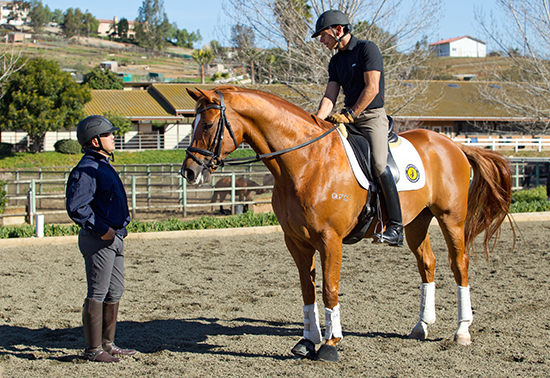
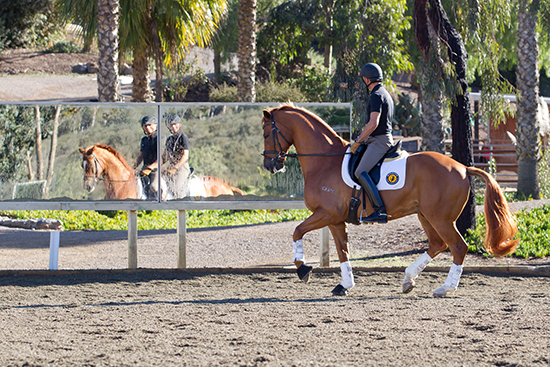
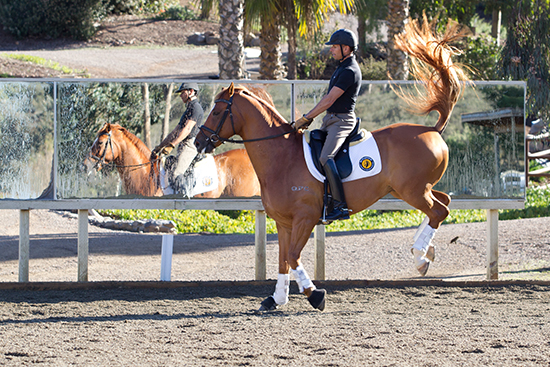
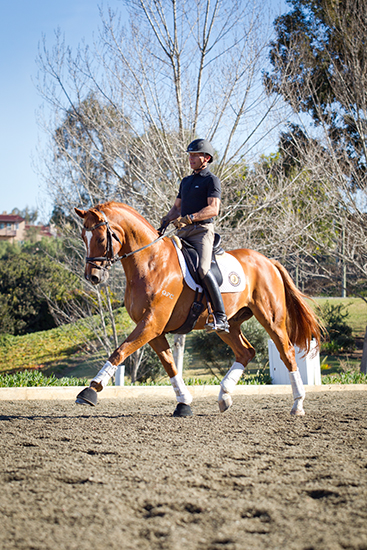
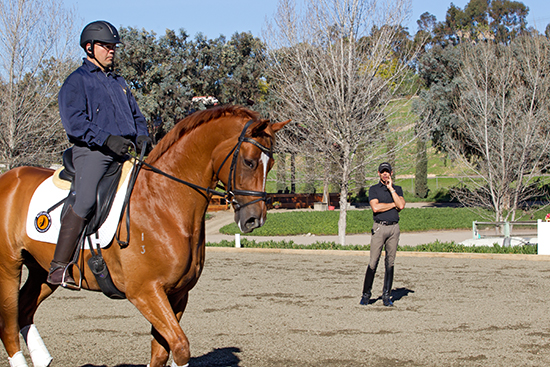
Gary
What an amazing story
How good are you